I haven't provided detailed commentary on the US labour market for a while now. To…
US labour market recovery leaves considerable slack and rising long-term unemployment
Last Friday (July 2, 2021), the US Bureau of Labor Statistics (BLS) released their latest labour market data – Employment Situation Summary – June 2021 – which showed that the recovery since the catastrophic labour market collapse in March and April 2020, continues with payroll employment rising by 850,000 in June 2021. The unemployment rate rose by 0.1 points to 5.9. However, the broader labour wastage captured by the BLS U6 measure fell by 0.4 points to 9.8 per cent. The US labour market is still 6,76 thousand jobs short from where it was at the end of February 2020, which helps to explain why there are no fundamental wage pressures emerging. The other notable point is that long-term unemployment now dominates among the duration categories published by the BLS.
Overview for June 2021:
- Payroll employment increased by 559,000.
- Total labour force survey employment fell by 18 thousand net (-0.01 per cent).
- The seasonally adjusted labour force rose by 151 thousand (0.09 per cent) after declining in May.
- Official unemployment rose by 168 thousand to 9,484 thousand.
- The official unemployment rate rose by 0.1 points to 5.9 per cent.
- The participation rate was unchanged 61.6 per cent.
- The broad labour underutilisation measure (U6) fell by 0.4 points to 9.8 per cent.
For those who are confused about the difference between the payroll (establishment) data and the household survey data you should read this blog post – US labour market is in a deplorable state – where I explain the differences in detail.
So we are now operating in an environment of minimal uncertainty.
Payroll employment trends
The BLS noted that:
Total nonfarm payroll employment rose by 850,000 in June, following increases of 583,000 in May and 269,000 in April. In June, nonfarm payroll employment is up by 15.6 million since April 2020 but is down by 6.8 million, or 4.4 percent, from its pre-pandemic level in February 2020 …
In June, employment in leisure and hospitality increased by 343,000, as pandemic-related restrictions continued to ease in some parts of the country … Employment in leisure and hospitality is down by 2.2 million, or 12.9 percent, from its level in February 2020.
In June, employment rose by 155,000 in local government education, by 75,000 in state government education, and by 39,000 in private education … Since February 2020, employment is down by 414,000 in local government education, by 168,000 in state government education, and by 255,000 in private education.
Employment in professional and business services rose by 72,000 in June but is down by 633,000 since February 2020 …
Retail trade added 67,000 jobs in June, but employment is down by 303,000, or 1.9 percent, since February 2020.
The other services industry added 56,000 jobs in June … Employment in other services is 297,000 lower than in February 2020.
Employment in social assistance rose by 32,000 in June … is down by 236,000 from its level in February 2020.
In June, wholesale trade added 21,000 jobs … is 192,000 lower than in February 2020.
Employment in mining rose by 10,000 in June … is down by 110,000 since a peak in January
2019.Employment in manufacturing changed little in June (+15,000) … is down by 481,000 from its level in February 2020.
Employment in transportation and warehousing was little changed in June (+11,000) … is down by 94,000.
Construction employment changed little in June (-7,000) … is 238,000 lower than in February 2020.
The first graph shows the monthly change in payroll employment (in thousands, expressed as a 3-month moving average to take out the monthly noise). The gray lines are the annual averages.
The data swings are still large and dwarf the past history.
The US labour market is still 6,764 thousand jobs short from where it was at the end of February 2020 and the commentary from the BLS above tells us how this shortfall is distributed across the sectors.
The next graph shows the same data in a different way – in this case the graph shows the average net monthly change in payroll employment (actual) for the calendar years from 2005 to 2021.
The final average for 2019 was 168 thousand.
The final average for 2020 was -785 thousand.
The average for 2021 (so far) is 543 thousand.
Labour Force Survey – employment falls
The data for June 2021 reveals:
1. Employment as measured by the household survey fell by 18 thousand net (-0.01 per cent).
2. The labour force rose by 151 thousand (0.09 per cent).
3. The participation rate was unchanged at 61.6 per cent.
4. As a result (in accounting terms), total measured unemployment rose by 168 thousand to 9,484 thousand and the unemployment rate fedged up 0.1 points to 5.9 per cent.
The BLS note that both unemployment measures:
Both the unemployment rate, at 5.9 percent, and the number of unemployed persons, at 9.5 million, were little changed in June. These measures are down considerably from their recent highs in April 2020 but remain well above their levels prior to the coronavirus (COVID-19) pandemic (3.5 percent and 5.7 million, respectively, in February 2020) …
In June, the number of long-term unemployed (those jobless for 27 weeks or more) increased by 233,000 to 4.0 million, following a decline of 431,000 in May. This measure is 2.9 million higher than in February 2020.
The following graph shows the monthly employment growth since January 2008, which shows the massive disruption this sickness has caused.
To put the recent period in perspective I took out the extreme observations (outliers) between March 2020 and October 2020 and repeated the graph.
This graph shows the current recovery more realistically.
The Employment-Population ratio is a good measure of the strength of the labour market because the movements are relatively unambiguous because the denominator population is not particularly sensitive to the cycle (unlike the labour force).
The following graph shows the US Employment-Population from January 1950 to June 2021.
While the ratio fluctuates a little, the April 2020 ratio fell by 8.6 points to 51.3 per cent, which is the largest monthly fall since the sample began in January 1948.
In June 2021, the ratio was unchanged at 58 per cent.
It is still well down on the level in February 2020 (61.1 per cent).
As a matter of history, the following graph shows employment indexes for the US (from US Bureau of Labor Statistics data) for the five NBER recessions since the mid-1970s and the current 2020-COVID crisis.
They are indexed at the employment peak in each case and we trace the data out for each episode until one month before the next peak.
So you get an idea of:
1. The amplitude (depth) of each cycle in employment terms.
2. The length of the cycle in months from peak-trough-peak.
The early 1980s recession was in two parts – a short downturn in 1981, which was followed by a second major downturn 12 months later in July 1982 which then endured.
Other facts:
1. Return to peak for the GFC was after 78 months.
2. The previous recessions have returned to the 100 index value after around 30 to 34 months.
3. Even at the end of the GFC cycle (146 months), total employment in the US had still only risen by 8.3 per cent (since December 2007), which is a very moderate growth path as is shown in the graph.
The COVID collapse was something else but the recent gains are evident, although the gains have been slowing relative to early in the recovery.
Unemployment and underutilisation trends
The first graph shows the official unemployment rate since January 1994.
The official unemployment rate is a narrow measure of labour wastage, which means that a strict comparison with the 1960s, for example, in terms of how tight the labour market, has to take into account broader measures of labour underutilisation.
The next graph shows the BLS measure U6, which is defined as:
Total unemployed, plus all marginally attached workers plus total employed part time for economic reasons, as a percent of all civilian labor force plus all marginally attached workers.
It is thus the broadest quantitative measure of labour underutilisation that the BLS publish.
Pre-COVID, U6 was at 6.8 per cent (December 2019).
In June 2021 the U6 measure was 9.8 per cent, a decline of 0.4 points on the previous month.
The part-time for economic reasons cohort (the US indicator of underemployment) fell by 644 thousand (-12.2 per cent), a substantial reduction in the recent monthly changes in underemployment.
The BLS say that:
The number of persons employed part time for economic reasons decreased by 644,000 to 4.6 million in June. This decline reflected a drop in the number of persons whose hours were cut due to slack work or business conditions. The number of persons employed part time for economic reasons is up by 229,000 since February 2020 …
In June, the number of persons not in the labor force who currently want a job was 6.4 million, little changed over the month but up by 1.4 million since February 2020. These individuals were not counted as unemployed because they were not actively looking for work during the last 4 weeks or were unavailable to take a job …
Among those not in the labor force who currently want a job, the number of persons marginally attached to the labor force, at 1.8 million, changed little in June but is up by 393,000 since February 2020. These individuals wanted and were available for work and had looked for a job sometime in the prior 12 months but had not looked for work in the 4 weeks preceding the survey.
Ethnicity and Education
The next graph shows the evolution of unemployment rates for three cohorts based on educational attainment: (a) those with less than high school completion; (b) high school graduates; and (c) university graduates.
As usual, when there is a crisis, the least educated suffer disproportionately.
In the collapse in employment, the unemployment rates rose by:
- 14.1 points for those with less than high-school diploma.
- 13.0 points for high school, no college graduates.
- 5.9 points for those with university degrees.
The period since April 2020 has seen the unemployment rate fall by:
- 10.8 points for those with less than high-school diploma meaning the unemployment rate is now 3.8 points above the March level.
- 10.3 points for high school, no college graduates meaning the unemployment rate is now 4.6 points above the March level.
- 5.9 points for those with university degrees meaning the unemployment rate is now 2.3 points above the March level.
In the last month, the change in the unemployment rate has been:
- rise of 1.1 points for those with less than high-school diploma – so this cohort is bearing the cost of the stalled recovery.
- rise of 0.2 points for high school, no college graduates.
- rise of 0.3 points for those with university degrees.
In the US context, the trends in trends in unemployment by ethnicity are interesting.
Two questions arise:
1. How have the Black and African American and White unemployment rate fared in the post-GFC period?
2. How has the relationship between the Black and African American unemployment rate and the White unemployment rate changed since the GFC?
Summary:
1. All the series move together as economic activity cycles. The data also moves around a lot on a monthly basis.
2. The Black and African American unemployment rate was 6.8 per cent in March 2020, rose to 16.7 per cent in May and is at 9.21 per cent in June 2021. In the last month, it rose by 0.1 points.
3. The Hispanic or Latino unemployment rate was 6 per cent in March 2020, rose to 18.9 per cent in April and is at 7.4 per cent in June 2021. In the last month, it rose by 0.1 points.
4. The White unemployment rate was 3.9 per cent in March 2020, rose to 14.1 per cent in April and fell to 5.2 per cent in June 2021. In the last month, it rose by 0.1 points.
The next graph shows the Black and African American unemployment rate to White unemployment rate (ratio) from January 2018, when the White unemployment rate was at 3.5 per cent and the Black or African American rate was at 7.5 per cent.
This graph allows us to see whether the relative position of the two cohorts has changed since the crisis.
If it is rising, then the unemployment rate of the Black and African American cohort is either rising faster than the white unemployment rate or falling more slowly (or a combination of that relativity).
While there is month-to-month variability, the data shows that, in fact, through to mid-2019, the position of Black and African Americans had improved in relative terms (to Whites), although that just reflected the fact that the White unemployment was so low that employers were forced to take on other ‘less preferred’ workers if they wanted to maintain growth.
In April 2019, the ratio was 2.1 (meaning the Black and African American unemployment rate was more than 2 times the White rate).
By April 2020, the ratio had fallen to its lowest level of 1.2, reflecting the improved relative Black and African American position.
As the pandemic hit, the ratio rose and peaked at 1.8 in October 2020.
In June 2021, the ratio was 1.77 – a fall of 0.1 points from the previous month.
Special Topic: Wage movements in the US labour market
I have been working on detailing whether there is an inflation threat emerging in the US.
One of the ways of assessing whether the US economy is close to full employment is to examine the growth in wages, which tells us whether the supply-side of the labour market (workers) is enjoying gains in bargaining power.
The other indicator is the rate at which workers are quitting their jobs, which provides a signal of mobility and confidence among workers. The most recent data is not yet available.
The BLS reported that:
Average hourly earnings for all employees on private nonfarm payrolls rose by 10 cents to $30.40 in June, following increases in May and April (+13 cents and +20 cents, respectively). Average hourly earnings of private-sector production and nonsupervisory employees rose by 10 cents to $25.68 in June. The data for recent months suggest that the rising demand for labor associated with the recovery from the pandemic may have put upward pressure on wages. However, because average hourly earnings vary widely across industries, the large employment fluctuations since February 2020 complicate the analysis of recent trends in average hourly earnings.
The following graph shows the annual hourly earnings growth for all private employees since March 2007.
The recent trend is downwards and dispels any notion that the US has reached the end of their expansionary capacity.
Noting that the above graph is in nominal terms.
The – BLS Real Earnings Summary (published June 10, 2021) – tells us that:
Real average hourly earnings for all employees decreased 0.2 percent from April to May, seasonally adjusted … This result stems from an increase of 0.5 percent in average hourly earnings combined with an increase of 0.6 percent in the Consumer Price Index for All Urban Consumers (CPI-U).
Real average weekly earnings decreased 0.1 percent over the month due to the change in real average hourly earnings combined with no change in the average workweek.
Real average hourly earnings decreased 2.8 percent, seasonally adjusted, from May 2020 to May 2021. The change in real average hourly earnings combined with an increase of 0.6 percent in the average workweek resulted in a 2.2 percent decrease in real average weekly earnings over this period.
And, from the latest – Productivity and Costs, First Quarter 2021, Revised (published June 3, 2021) – report, we find that:
Nonfarm business sector labor productivity increased 5.4 percent in the first quarter of 2021 … as output increased 8.6 percent and hours worked increased 3.0 percent.
So real hourly earnings growth is still lagging behind the annual productivity growth, which is another sign of labour market slack and weak bargaining power.
The following graph shows movements in real average hourly earnings (indexed at 100 the pre-GFC peak – November 2006) up to May 2021 (latest data).
The faster growth as the recovery gained speed ended in early 2016
The spike in the early period of the pandemic was the result of hours adjustments rather than earnings growth.
The series is now 4.6 points below the pre-pandemic levels.
It is hard to see major structural inflation pressures arising as a result of these movements.
Special Topic: Trends in long-term unemployment
The Bureau of Labor Statistics defines long-term unemployment differently to most other national statistical agencies.
They use the 27 weeks or more threshold, whereas most other agencies use the more than a year benchmark.
The following graph shows the unemployment rate (green) and the proportion of long-term unemployed in total unemployment from January 1950 to June 2021.
While the definition is different, the behaviour of long-term unemployment is similar across nations.
The feature is the rising PLTU trend since the 1980s.
Even as the official unemployment rate has eventually returned to its pre-recession levels (right-hand axis in percent), the duration of the recovery has become longer, which means that the pool of unemployed ‘ages’ in duration and increasing numbers of people are in the long-term unemployment category..
This is one of the reasons that governments should try to short-circuit downturns to stop that effect.
Remember that the PLTU lags the changes in actual unemployment.
Before the pandemic, the average duration of unemployment was 4.2 weeks (April 2021).
The average duration in June 2021 was 29.6 weeks, which means that on average each unemployed person is classified as long-term unemployment.
This indicates a very stagnant dynamic.
New entrants are getting the jobs and those who lost out early in the pandemic are becoming stuck.
I will do some more analysis of these flows in later posts as I understand the data trends better.
You can find an excellent BLS discussion of long-term unemployment dynamics presented in this article (July 2016) – An analysis of long-term unemployment.
Conclusion
The June 2021 US BLS labour market data release suggests that the labour market is recovering but considerable slack remains.
It is clear though that the US labour market is still 6,764 thousand jobs short from where it was at the end of February 2020.
There is no sign of any wage pressures accelerating.
That is enough for today!
(c) Copyright 2021 William Mitchell. All Rights Reserved.
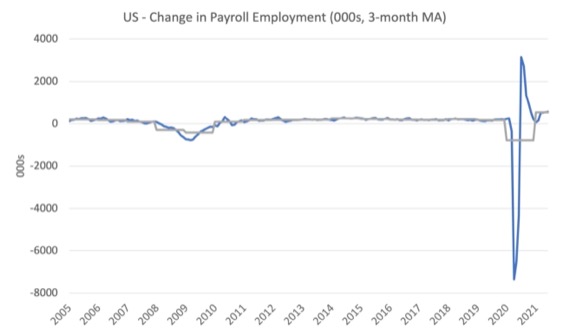
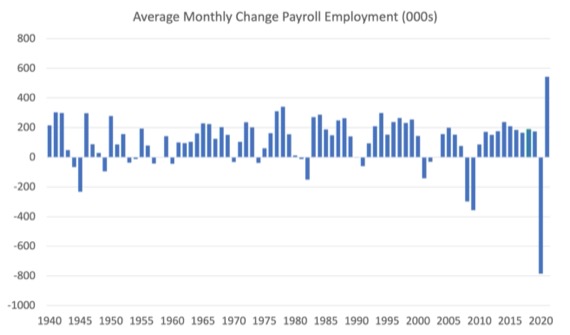
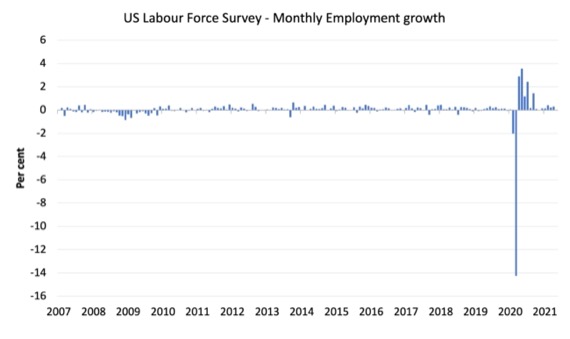
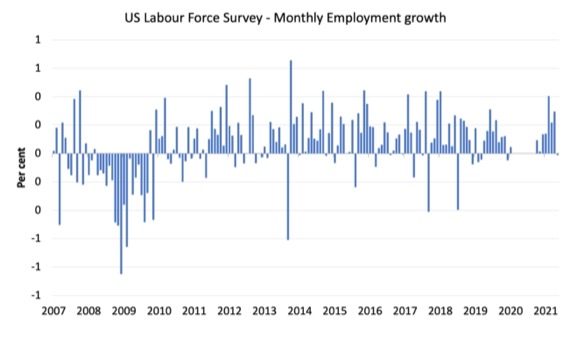
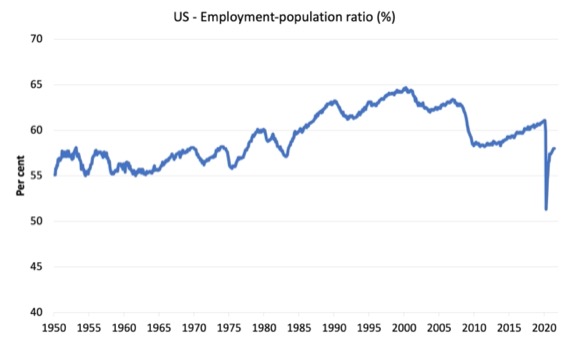

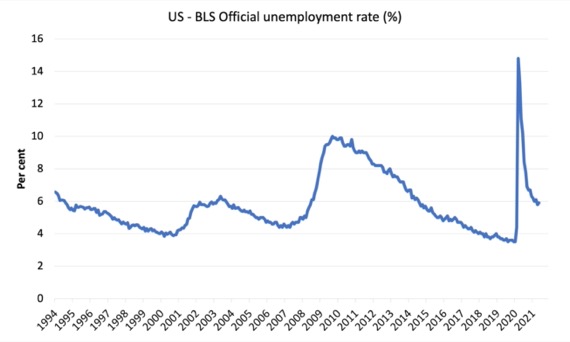

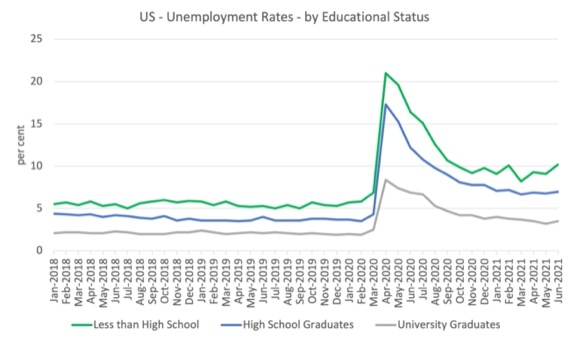
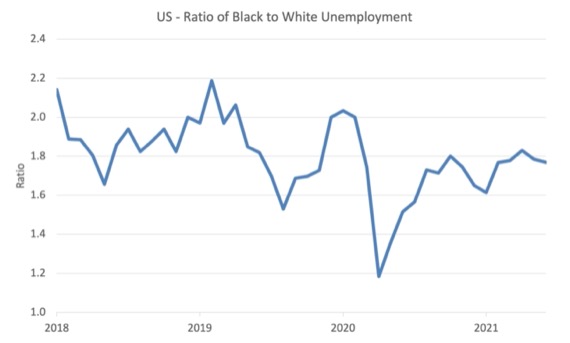
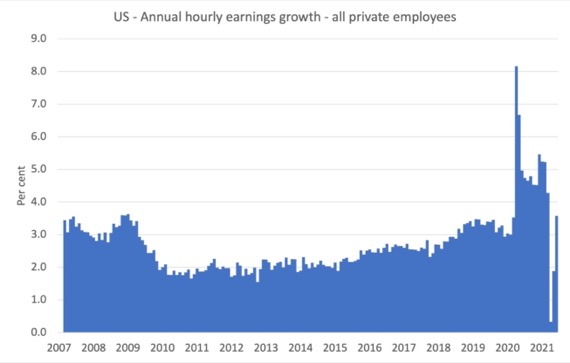
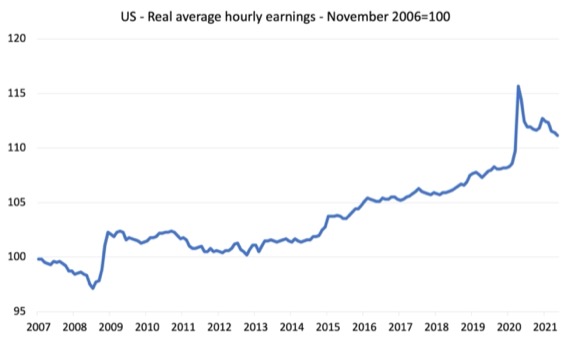
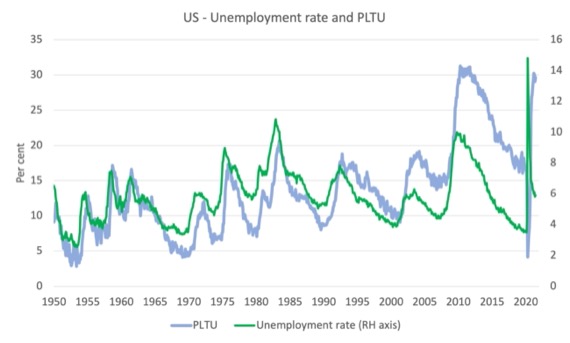
Dear Bill,
I don’t pretend to have followed the story very closely, but hasn’t unemployment benefit been extended in the US, so that many more workers are currently categorised as unemployed, and have been for much longer than usual? So the increase in long-term unemployment is simply a reflection of ongoing government support, and does not tell us much about the state of the labour market?